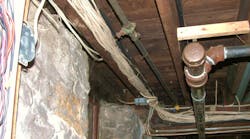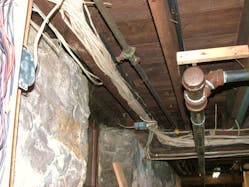How well do you know the Code? Think you can spot violations the original installer either ignored or couldn't identify? Here's your chance to moonlight as an electrical inspector and second-guess someone else's work from the safety of your living room or office. It's your turn to identify the violation.
Hint: A bundle of joy
Find the Answer
While this bundle itself is not a violation, the NM cable used to support the whole bundle is most certainly a Code violation. Section 300.11(C) prohibits cable wiring methods from being used "as a means of support for other cables, raceways, or nonelectrical equipment."
In this installation, there are only a couple of NM cables stapled to the side of the joist, and all of the other NM cables are bundled and secured to those original cables. This could cause damage to the stapled cables, since it adds significant weight onto the cable jacket, insulation, and conductors of the original cables. This can be a common problem where installers simply run out of room to staple any more cables onto the beam. Instead of installing running boards or using a different joist, installers will mistakenly tie-wrap cable after cable onto those that were originally stapled to the beam.
Although bundling of NM cables is not a violation of the Code, installers must also be aware of the requirements to adjust the ampacity of the conductors in accordance with 310.15(B)(3). Where single or multi-conductor cables are installed similar to this installation, "longer than 24 in. without maintaining spacing," the allowable ampacity of each conductor shall be reduced in accordance with table 310.15(B)(3)(a).





